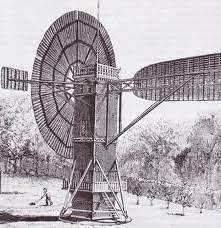Many HAWT [horizontal axis wind turbines] are stall controlled. That is, when the windmill is overpowered, the are not speed up but instead retain more constant or slower rotational speed so that the angle of attack [AoA] increases and the blades stall. This in turn reduces power output. A simple and cheap scheme that does not require blade pitch control.
I was thinking, is this possible to transfer to a TRPT rig [torsional rotary power transfer, eg Rod Read’s Daisy]?
Well; a TRPT can only apply a certain amount of torque before the soft shaft collapses. This is usually the same torque that provides the maximum power output. But the max torque of the soft shaft may also be bigger than the optimum torque setting if the shaft is over-dimensioned, leading to possible feasibility of what I am about to describe.
It does occur to me though, that it is possible to control the AoA through the harvesting force if each kite has two tethers connected at the front and back of the fuselage.
I have simplified the TRPT into a cart with a harvesting force to make explanation easier.
The starting point is adding a second tether to the kites of the TRPT so that it is pitch controlled. The length of the tethers may be fixed.
In nominal conditions, the TRPT should be running at optimal AoA [the center drawing].
If we brake down the TRPT by applying a larger harvesting force, the AoA of the kites increases, causing it to enter stall eventually. This may possibly be used in super high wind conditions to prevent runaway power output.
Also, if we speed up the cart by reducing or removing the harvesting force, the AoA will be reduced until the tether tension and thus the power output is very low.
I guess this is inevitably going to be a hard thing to stabilize control wise, but maybe not impossible.
There are some obvious variations on the theme where the length of the tethers may be adjusted by winches to control power output. Though this does not constitute the simplest possible system IMHO.
stall_trpt.pdf (19.2 KB)



